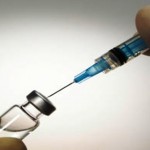 Researchers at The University of Texas at Austin have developed a menu of 61 new strains of genetically engineered bacteria that may improve the efficacy of vaccines for diseases such as flu, pertussis, cholera and HPV.
Researchers at The University of Texas at Austin have developed a menu of 61 new strains of genetically engineered bacteria that may improve the efficacy of vaccines for diseases such as flu, pertussis, cholera and HPV.
The strains of E. coli, which were described in a paper published this month in the journal PNAS, are part of a new class of biological “adjuvants” that is poised to transform vaccine design. Adjuvants are substances added to vaccines to boost the human immune response.
“For 70 years the only adjuvants being used were aluminum salts,” said Stephen Trent, associate professor of biology in the College of Natural Sciences. “They worked, but we didn’t fully understand why, and there were limitations. Then four years ago the first biological adjuvant was approved by the Food and Drug Administration. I think what we’re doing is a step forward from that. It’s going to allow us to design vaccines in a much more intentional way.”
Adjuvants were discovered in the early years of commercial vaccine production, when it was noticed that batches of vaccine that were accidentally contaminated often seemed to be more effective than those that were pure.
“They’re called the ‘dirty little secret’ of immunology,” said Trent. “If the vials were dirty, they elicited a better immune response.”
What researchers eventually realized was that they could produce a one-two punch by intentionally adding their own dirt (adjuvant) to the mix. The main ingredient of the vaccine, which was a killed or inactivated version of the bacteria or virus that the vaccine was meant to protect against, did what it was supposed to do. It “taught” the body’s immune system to recognize it and produce antibodies in response to it.
The adjuvant amplifies that response by triggering a more general alarm, which puts more agents of the immune system in circulation in the bloodstream, where they can then learn to recognize the key antigen. The result is an immune system more heavily armed to fight the virus or bacteria when it encounters it in the future.
For about 70 years the adjuvant of choice, in nearly every vaccine worldwide, was an aluminum salt. Then in 2009, the FDA approved a new vaccine for human papillomavirus (HPV). It included a new kind of adjuvant that’s a modified version of an endotoxin molecule.
These molecules, which can be dangerous, appear on the cell surface of a wide range of bacteria. As a result, humans have evolved over millions of years to detect and respond to them quickly. They trigger an immediate red alert.
“In some of its forms an endotoxin can kill you,” said Trent. “But the adjuvant, which is called MPL, is a very small, carefully modified piece of it, so it’s able to trigger the immune response without overdoing it.”
What Trent and his colleagues have done is expand on that basic premise. Rather than just work with an inert piece of endotoxin, they’ve engineered E. coli bacteria to express the endotoxin in many configurations on the cell surface.
“These 61 E. coli strains each have a different profile on their surface,” said Brittany Needham, a doctoral student in Trent’s lab and the first author on the paper. “In every case the surface structure of the endotoxin is safe, but it will interact with the immune system in a range of ways. Suddenly we have a huge potential menu of adjuvants to test out with different kinds of vaccines.”
One form might work better with cholera vaccine, another with pertussis (whooping cough) and another with a future HIV vaccine. Trent, Needham and their colleagues should be able to fine-tune the adjuvants with increasing precision as more E. coli strains are engineered and tested, and as their understanding of how they interact with the immune system deepens.
“I think we’re at the dawn of a new age of vaccine design,” said Trent. “For a long time vaccinology was really a trial-and-error field. It was a black box. We knew certain things worked. We knew certain vaccines had certain side effects. But we didn’t entirely know why. Now that’s changing.”
Trent said that an additional advantage of their system is that the E. coli can be engineered to express key viral and bacterial antigens along with the endotoxin. A single cell could deliver both parts of the one-two punch, or even a one-two-three punch, if antigens from multiple diseases were expressed in a single E. coli.
“It makes possible a vaccine that provides protection from multiple pathogens at the same time,” said Trent.
Trent and his colleagues are working on a second round of designer E. coli. They have also filed a provisional patent on their system and are working with the university to find a corporate partner to pay for clinical trials.
“This is ready to go,” said Trent. “I can’t predict whether it will actually make it to the market. But it’s very similar to the adjuvant that has already been approved, and my instinct is that if a company will undertake to do the trials, it will get approved. A company could call us tomorrow, we could send them a strain, and they could start working.”
Source: University of Texas at Austin

















